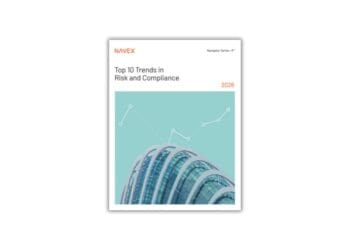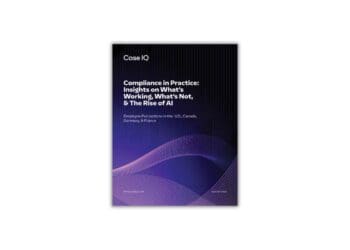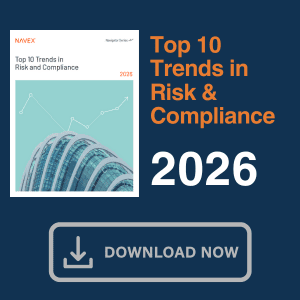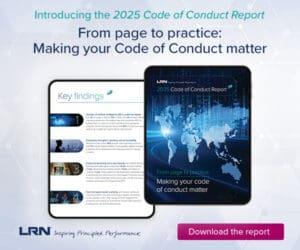The words that make up your compliance program documents are critical, there’s no doubt about that. But they will only ever be words on a page if their structure and design are disconnected. Mark Beyer, a trade compliance consultant, explores the principles of compliance program documentation through the lens of an ancient axiom: as above, so below.
The phrase “as above, so below,” the origin of which dates to sometime after 200 CE, suggests that patterns and principles at one level reflect those at another. This ancient axiom speaks to a profound unity and connection between the layers that exist.
Within systems thinking, we see this similar concept in the idea that systems are nested within larger systems. The layers are interdependent and connected through feedback loops; they influence and reinforce one another rather than functioning in isolation.
Imagine a tree; on the surface, you see its trunk and branches reaching up, but beneath the surface lies a hidden world just as vital if not more important. You find an intricate network of roots, silently anchoring the tree to the earth.
In the context of trade compliance, this concept reflects the importance of aligning overarching principles with the many operational program documents that implement them. Corporate value statements, codes of conduct and overarching policies (above) must translate into effective guidance and resources on the ground (below). This alignment ensures that the program is not only effective but that it cultivates a culture of accountability and continuous improvement.
Imagine your code of conduct and trade compliance policy as the branches of the tree, visible and not forgotten. But these resources are merely words on a page — ineffective and purposeless — without the supporting procedures, work instructions, checklists, guidance documents and forms that bring them to life.
The role of rules
Rules are the principles that govern behavior or serve to create order, set expectations and ensure safety. Rules play a foundational role in achieving and maintaining compliance. They provide clear, measurable standards that define boundaries. As trade compliance professionals, we rely on rules like our code of conduct, trade compliance policies and other documents to help translate complex export, import, sanctions or boycott requirements. Rules allow us to create a framework that supports accountability, reduces trade risk and ensures uniformity in processes. Well-defined rules serve as the backbone of an effective trade compliance program.
In a classic Jerry Seinfeld bit, he compares the complexity and abundance of laws and regulations (i.e., rules) to the rules within board games. He jokes that lawyers (or in our case, trade compliance professionals) exist because people cannot follow simple rules. Arguments break out even though the rules are right on the lid of the box. Seinfeld points out the irony that, despite having clear instructions, people still need someone to interpret and enforce the rules, his punchline revolving around the idea that the real reason we need so many lawyers (or trade compliance professionals) is because we cannot agree on what the rules mean and that lawyers (or trade compliance professionals) are the only ones that have read and understand the box lid.
One point you can glean from Seinfeld’s bit is that employees may not pay much attention to the rules but still will find a way to play the game. This is where the effectiveness of our trade compliance programs come into view.
From my experience, one key difference between an effective trade compliance program and a “paper program” is how we design the documents that interpret the rules. Far too often, organizations have looked at things like values, codes of conduct and policies as obligatory. People in those organizations assume that those documents exist, that they are like everyone else’s and therefore do not pay much attention to what they say.
Those organizations use templates they find online, get generic documents from consultants where they just change the company name, or worse yet, have ChatGPT write it for them. The documents are not operational in any way and really simply exist, which allows the organization to see that they are achieving that element of an effective compliance program. “Do we have a policy? Check!”
What Is Your Company’s Code of Ethics Missing?
Instilling an ethical framework is only the first step
Read moreDetailsThere’s got to be a better way
Using another Seinfeld reference, in the words of Frank Costanza, when talking about Christmas and his founding of the Festivus holiday: “… there’s got to be a better way!” The better way is by looking at program documentation as interdependent and interconnected, which can be done through a focus on structure and design.
Policies, procedures, operational playbooks, work instructions, guidelines and forms should be looked at in a linear fashion. They should be more than individual documents; they should be figuratively and literally connected.
The code of conduct should be written such that it refers to, and authorizes, the overarching trade compliance policy. The trade compliance policy should draw a connection to the procedures and operational playbooks that exist. The procedures and operational playbooks should link to the work instructions and guidelines that employees can use to interpret the rules. Any forms or other resources should be intertwined throughout the documents for ease of access and to clarify the process. The values, code of conduct and overarching policy is the “above,” while the procedures, operational playbooks, work instructions, guidelines and forms are the “below.” The structure of these program documents should not allow them to be seen as separate things, but rather they should be looked at as a system that works together to promote efficiency, reduce risk and ensure alignment.
When talking about the design of these documents, the goal should not be simply to get something in place. All too often, trade compliance leaders come across a need for a policy or procedure and they do not have much time to have something in front of their employees. We have all been there.
The result leads to drafting something using some generic template because, after all, something is better than nothing, right? Wrong. Poor program documentation not only will be ineffective, but it will undermine the program. Sure, they check the box, but they fall short when looking at them from an operational perspective. The key is to keep tone, visual appeal and consistency in mind.
The tone of the document sets the context in which the message is received and dictates how the content is interpreted. Each organization is different, and for a document to be effective it needs a well-matched tone to build trust and maintain credibility. The documents in the “above” layers should have a different tone because they are intended for a different audience or for a different purpose than the documents in the “below” layers. One layer expresses the why behind the rules, while the other sets out to describe the what and how.
The visual appeal of the document is often missed. The organization of the content, the use of the white space, the balance between words and graphics — all this plays into the likelihood of the document being read and understood. When a procedure is clearly organized, with clean formatting, logical headings, bullet points and diagrams or graphics where needed, it feels more approachable and user-friendly. If the layout is cluttered, overly dense or confusing, people are more likely to see the process as complicated or overwhelming. No matter how good or legally accurate the content is, it does not matter if it is not read. Poor design is a recipe for the document being ignored altogether.
The consistency of the document, both within it and across other documents, is important because it shows intentionality. Consistently written policies and procedures are more likely to be respected by employees and other stakeholders. Policies, procedures, operational playbooks, work instructions, guidelines and forms in which the little things are consistent lead to predictable, reliable outcomes. Employees are more likely to know exactly what is expected, which helps support training and accountability. Consistency is especially critical for audit readiness because it creates a stable foundation for effective, high-quality work.
The other side of the coin
Trade compliance leaders, and compliance leaders in general, are challenged with walking a fine line between the inherent bureaucracy involved in regulatory compliance and the culture or perception that our employees may have about the government and regulations.
We live in an increasingly legalistic but polarized society, and when talking about the structure and layers of policies, procedures, guidelines and forms, employees are quick to have a negative impression. Taking the hardline position with employees that they must follow the rules because the government says so is not an effective approach from a cultural perspective.
Instead, we need to take a page from our marketing colleagues and incorporate design principles into the creation of our trade compliance program documentation. Where can we use choice architecture when presenting options? How can we make certain elements stand out better to reinforce a point? When can we leverage social norms?
Rather than just focusing on the words on the page, it can be just as important to focus on how we present the information. By focusing the design of our program document not only on conveying information but also on changing behavior toward compliance, we can truly have an effective trade compliance program.



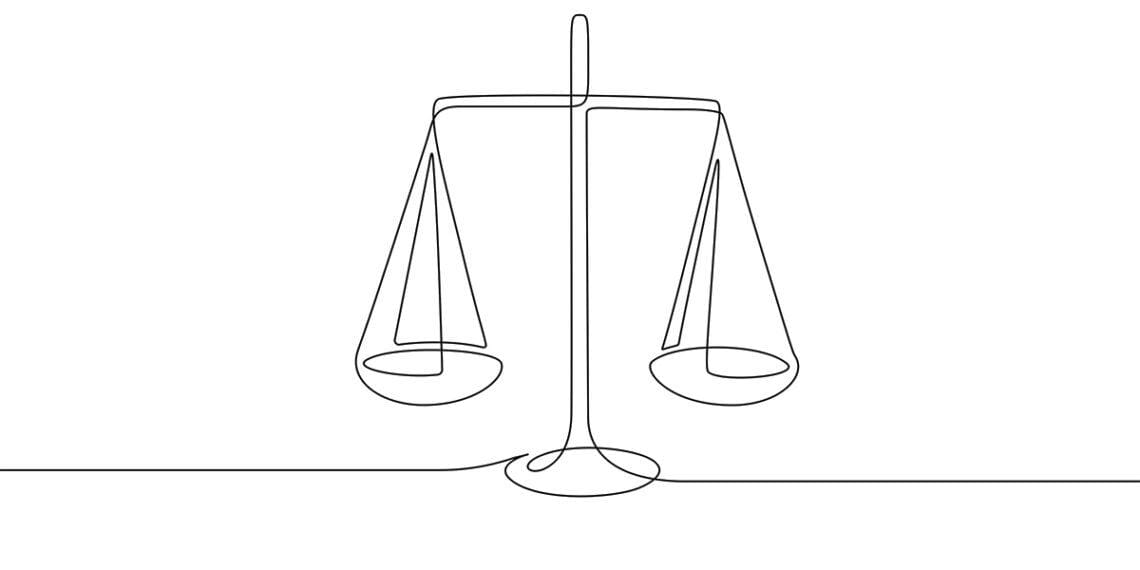
 Mark Beyer has 20 years of experience as a compliance professional, implementing and managing ethics and compliance programs and leading compliance projects for companies in the aerospace, oil and gas, medical device and utilities industries. Beyer is the program and project leader for Amalie Trade Compliance Consulting. He has developed a mix of compliance experience in areas like trade compliance, general business ethics, anti-bribery and anti-corruption, third-party due diligence, behavior science, privacy, environmental compliance and more.
Mark Beyer has 20 years of experience as a compliance professional, implementing and managing ethics and compliance programs and leading compliance projects for companies in the aerospace, oil and gas, medical device and utilities industries. Beyer is the program and project leader for Amalie Trade Compliance Consulting. He has developed a mix of compliance experience in areas like trade compliance, general business ethics, anti-bribery and anti-corruption, third-party due diligence, behavior science, privacy, environmental compliance and more. 